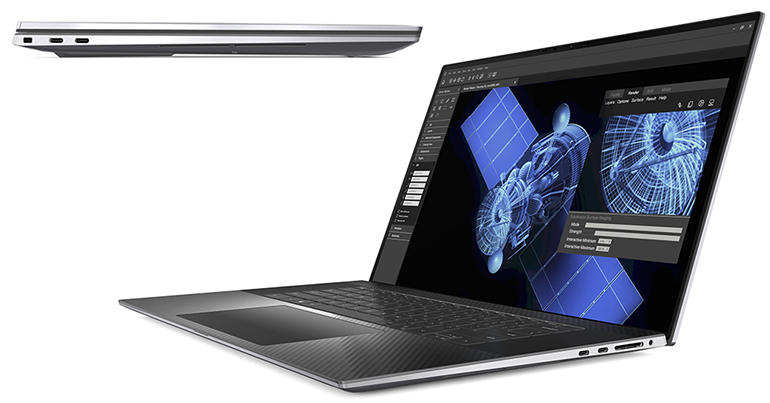After several years when laptop design has very much focused on slim and stylish ultraportable laptops, it looks as though larger devices are now making something of a comeback. That trend has doubtless been encouraged by the fact that worldwide business travel has virtually ground to a halt in recent months, making weight less of an issue for many business users. And, with millions of people now working from home, more powerful laptops with larger displays can seem like an attractive option, especially for creative users who need a laptop with a discrete GPU to handle 3D graphics and video.
As is so often the case, it was Apple that kick-started this trend, with the revamped 16-inch MacBook Pro, launched in 2019. This was followed by Dell’s updated Precision 7740, which offered an imposing 17-inch display and workstation- level graphics performance. But while the Precision 7740 delivered impressive performance, it also weighed in at just over 3.0kg, compared to 2.0kg for the 16-inch MacBook Pro. So Dell recently introduced its new 5000 Series, headed by the Precision 5750, which offers similar workstation-class performance in a more streamlined design.
The 17-inch Precision 5750 runs Windows 10 Pro or Ubuntu Linux on 10th-generation Intel Xeon W or Core i5/i7/i9 processors with up to 64GB of RAM and up to 4TB of SSD storage. The 500-nit display can be FHD+ (1920×1200) or UHD+ (3840×2400) resolution — the latter with 10-finger touch functionality. Nvidia GPU options are Quadro T2000 and Quadro RTX 3000.
Images: Dell
Features, design & display
Dell boasts that the Precision 5750 is “the world’s smallest and thinnest 17-inch workstation”, and it’s hard to dispute that claim. The starting weight is quoted at 2.17kg, although our customised review unit was closer to 2.4kg. Even so, that’s still a good weight for a laptop with a 17-inch display, while the edge-to-edge glass panel helps to keep the overall dimensions to 375mm wide and 248mm deep. It’s also remarkably slim for such a powerful laptop, measuring 13.15mm along the rear edge, and tapering to just 8.7mm at the front.
There are two display options available for this 17-inch system, with the least expensive providing FHD+ resolution (1920×1200 pixels). However, that seems like an odd — if not downright unwise — compromise for a high-end laptop such as this. Most users will probably prefer to opt for the touch-sensitive UHD+ display provided with our review unit, which provides 3840-by-2400 resolution (266ppi) and a 16:10 aspect ratio.
The UHD+ display is impressively bright and sharp, although to my naked eye the colours did seem a little over-saturated at times. However, Dell states that this display supports HDR 400 and 100% of Adobe RGB, so it should be well suited to graphic design and photo-editing work. It’s surprising, though, that Dell’s extensive options don’t include a display that also supports the DCI-P3 colour standard that’s widely used for professional video-editing — especially as Dell itself mentions ‘media and entertainment’ as a key target audience.
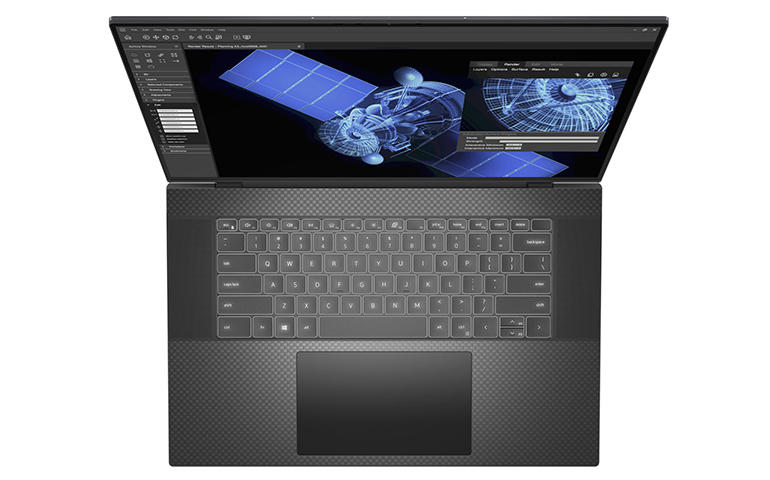

The full-size keyboard has optional backlighting and an optional fingerprint reader embedded in the power button. The large touchpad supports 5-finger multi-touch.
Image: Dell
The 720p webcam is also a little disappointing in such a high-end laptop, as many prefer a 1080p webcam for video calls when working from home.
Top ZDNET Reviews
Connectivity is good, though, with four Thunderbolt 3/USB-C ports, an SD card slot, an 3.5mm audio jack and support for WiFi6 (a.k.a. 802.11ax). Dell even throws in a useful USB-C adapter that provides an additional HDMI interface for an external display, and USB-A for older accessories (something Apple normally charges £50 extra for). The base of the laptop is held in place by eight torx screws, and Dell’s service manual provides instructions for replacing RAM and storage modules, so more experienced users will be able to perform some repairs and upgrades for themselves.
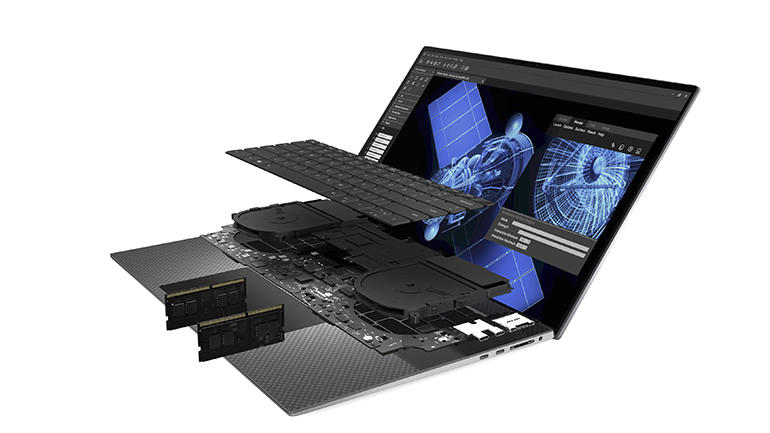

RAM (up to 64GB in 2 SODIMM slots) and SSD storage (up to 4TB in 2 Gen 3 PCIe NVMe x4 slots) can be upgraded by the user.
Image: Dell
Price & options
The Precision 5750 is listed on Dell’s UK website as a Build Your Own (BYO) system that allows you to specify virtually every key component, from the processor, memory and storage, right down to the choice of battery and power supply.
Dell’s pricing seems to vary on an almost daily basis, but at the time of writing the entry-level BYO configuration was £2,319.71 (ex. VAT; £2,783.65 inc. VAT) with a quad-core Core i5-10400H processor, 16GB of RAM, a 256GB PCIe NVMe SSD and discrete Nvidia Quadro T2000 graphics with an FHD+ display.
However, our review unit was a top-of-the-range configuration, equipped with an 8-core Core i9-10885H processor running at 2.4GHz (up to 5.3GHz with TurboBoost) along with 64GB of RAM and two 1TB PCIe NVMe SSDs. As mentioned, this model also opts for the touch-sensitive UHD+ (3840×2400) display, which is driven by a discrete Nvidia Quadro RTX 3000 GPU with 6GB of dedicated video RAM, for a total price of £4,454.96 (ex. VAT; £5,345.95 inc. VAT).
Customers in the US have a more limited choice, as the Precision 5750 currently only seems to be available with Core i5 and Core i7 processors, and FHD+ displays. Prices in the US start at $2,139 for an entry-level Core i5 configuration with integrated graphics only, rising to $3,079 with a Core i7 CPU and Quadro RTX 3000 dGPU.
Performance
The Precision 5750 has the same RTX 3000 graphics card as the heavier Precision 7740 that we reviewed in January, although it benefits from a newer 10th-generation Core i9 processor. As a result it edges slightly ahead on processor performance in Geekbench 5, recording scores of 1,290 for single-core performance and 7,600 for multi-core, compared to 1,200 and 7,000 respectively, for the Precision 7740.
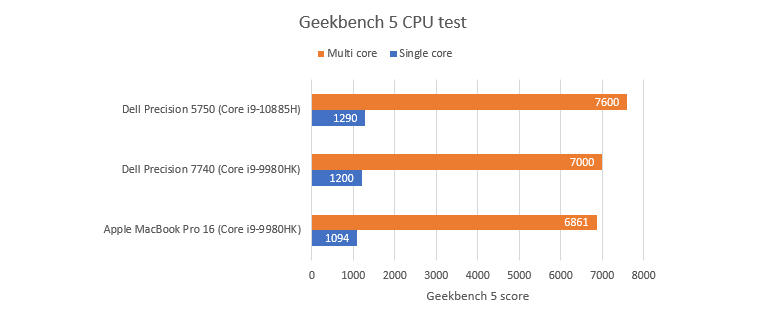

Graphics performance is very similar, though, with the Precision 5750 achieving 220fps with Cinebench R15, and 74.5fps on the more demanding Unigine Valley — only fractionally ahead of the Precision 7740 at 205fps (Cinebench R15) and 73fps (Unigine Valley).
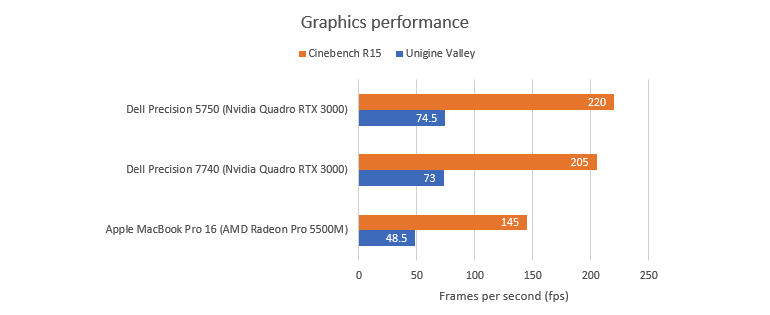

However, there’s an area where the Precision 5750 significantly outguns its larger counterpart. Even when using its less power-hungry integrated graphics, the Precision 7740 could only manage 3 hours and 10 minutes of streaming video from its 6-cell 97Wh battery. In contrast, the integrated graphics of the Precision 5750 lasted for a more respectable 7 hours and 10 minutes with the same battery capacity. Admittedly, Apple’s 16-inch MacBook Pro outlasted both of its Dell rivals at just over 11 hours from a 100Wh battery, but its graphics performance was considerably weaker — 145fps in Cinebench R15 and 48.5fps in Unigine Valley.
Impressively, the Precision 5750 was almost silent during our tests. Even after repeatedly running the intensive Unigine Valley tests, it produced only a very low hum from its twin-fan cooling system, with just a mild feeling of warmth drifting up through the keyboard panel.
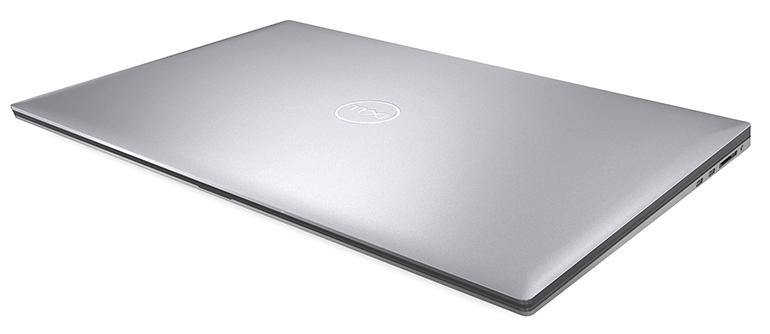

Conclusions
If weight and battery life aren’t particularly important, then the Precision 7740 will provide workstation performance at a slightly lower price. However, the Precision 5750 is considerably lighter and provides superior battery life, while offering a slight edge on performance. It’s no ultraportable, but if you need a laptop that can deliver genuine workstation-class graphics performance both on the desktop and on the road, then the Precision 5750 is hard to beat.
RECENT AND RELATED CONTENT
Dell Precision 7740 review: A weighty 17-inch mobile workstation that packs a punch
HP ZBook 17 G6 review: A heavy-duty, user-upgradable mobile workstation
Apple MacBook Pro (16-inch, 2019) review: Bigger and better, but still expensive
The new M1 Macs make cutting-edge, machine-learning workstations
How to choose the right PC: Everything you need to know about picking the right computer for work
The best laptop docking stations: Your essential accessory for working from home
Read more reviews
